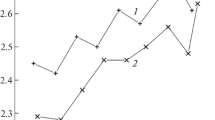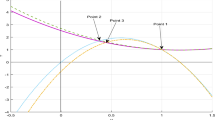Abstract
The direct simulation Monte Carlo method is used to numerically simulate the problem of the shock wave front in vibrationally excited hydrogen flowing in the low-pressure channel of a shock tube. It is assumed that the vibrational temperature of the hydrogen equals 3000 K. The cases of partially and completely excited hydrogen are considered. Equilibrium hydrogen is applied as a pusher gas, but its concentration is 50 times higher than the hydrogen concentration in the low-pressure channel. In addition, the strength of the shock wave is varied by heating the pusher gas. It has been shown that, if the prestored vibrational energy is weakly converted to translational energy, the shock wave slows down over time. If the energy conversion is sufficiently intense, when the pusher gas is warm and only completely vibrationally excited hydrogen is in the low-pressure channel, the wave gains speed over time (its velocity increases roughly by a factor of 1.5). This causes physical detonation, in which case the parameters of the wave become dependent on the vibrational-to-thermal energy conversion and independent of the way of its initiation.
Similar content being viewed by others
References
Physics of Explosion, Ed. by L. P. Orlenko (Fizmatlit, Moscow, 2002), Vol.1.
N. V. Evtyukhin, A. D. Margolin, and V. M. Shmelev, Khim. Fiz. 4, 1276 (1985).
G. A. Bird, Molecular Gas Dynamics (Clarendon, Oxford, 1976; Mir, Moscow, 1981).
S. V. Kulikov, Khim. Fiz. 27 (12), 40 (2008).
S. V. Kulikov and O. N. Ternovaya, Vychisl. Metody Program. 5 (2), 5 (2004).
M. Snir, S. Otto, S. Huss-Lederman, D. Walker, and J. Dongarra, MPI: The Complete Reference, Vol. 1: The MPI Core (MIT, Boston, 1998).
J. H. Kiefer and R. J. Lutz, J. Chem. Phys. 44, 668 (1966).
S. V. Kulikov, G. A. Pokatovich, and O. N. Ternovaya, Khim. Fiz. 27 (5), 49 (2008).
Author information
Authors and Affiliations
Corresponding author
Additional information
Original Russian Text © S.V. Kulikov, N.A. Chervonnaya, O.N. Ternovaya, 2016, published in Zhurnal Tekhnicheskoi Fiziki, 2016, Vol. 86, No. 8, pp. 42–47.
Rights and permissions
About this article
Cite this article
Kulikov, S.V., Chervonnaya, N.A. & Ternovaya, O.N. Statistical simulation of the flow of vibrationally preexcited hydrogen in a shock tube and the possibility of physical detonation. Tech. Phys. 61, 1162–1167 (2016). https://doi.org/10.1134/S106378421608017X
Received:
Published:
Issue Date:
DOI: https://doi.org/10.1134/S106378421608017X




